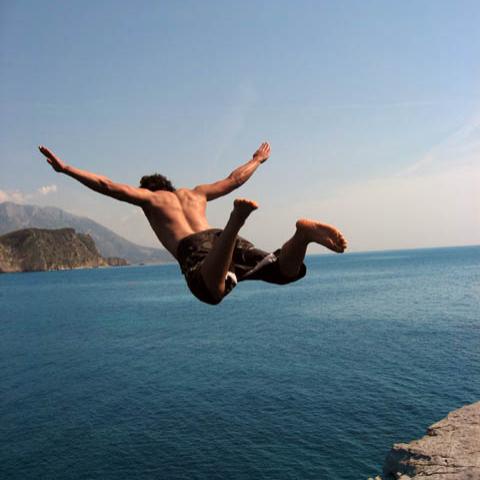Jump off a HIGH CLIFF
 Cliff diving from any height can't be called safe -- it's one of the most dangerous extreme sports. In fact, official tourism sites of popular cliff diving destinations don't promote the activity.
Cliff diving from any height can't be called safe -- it's one of the most dangerous extreme sports. In fact, official tourism sites of popular cliff diving destinations don't promote the activity.Cliff diving puts tremendous stresses on your body. If you jump from 20 feet (6 meters) above the water, you'll hit the water at 25 mph (40 kph) -- the impact is strong enough to compress your spine, break bones or give you a concussion. But that's only if you enter feet-first in a straight, vertical line -- a horizontal, or "pancake," landing is like hitting concrete. Halving the height of the jump to 10 feet (3 meters), as mentioned earlier, reduces your speed of impact to 17 mph (27 kph), and even cars sustain damage when hit at that speed.
Because of the high potential for injury, the World High Diving Federation recommends that no one dive from 20 meters (65.5 feet) or higher unless there are professional rescue scuba divers stationed in the water.
Cliff Diving Tips
If you're overcome with the desire to experience the thrill of cliff diving, follow these tips to improve your chances of swimming out unharmed:
- Start low and slow. Before you head to the cliffs, practice the pencil dive from high-dive platforms at a swimming pool. In a pencil dive, you strive to make your body as slim and straight as a pencil. Jump feet first with your arms held tightly to your sides and your feet pressed together and pointed downward. This minimizes the surface area that strikes the water, reducing the force of impact.
- Use the buddy system. Don't dive alone.
- Explore the water. Before diving, swim around your landing area to check the depth of the water and search for any obstacles.
- Plan your exit. Before you plunge into the water, plan where you'll get out and how you'll get back.
- Dress for success. A wetsuit adds a layer of cushioning between you and the water. Skip the water shoes, though, to reduce the surface area of the first body part that makes impact with the water.
- Keep it simple. You need to enter the water in a straight, vertical line. Any deviation from this toes-first, narrow-entry position risks injury and assures increased pain. Midair flips and twists can send you askew, so leave those to professionals.
Source: adventure.howstuffworks.com